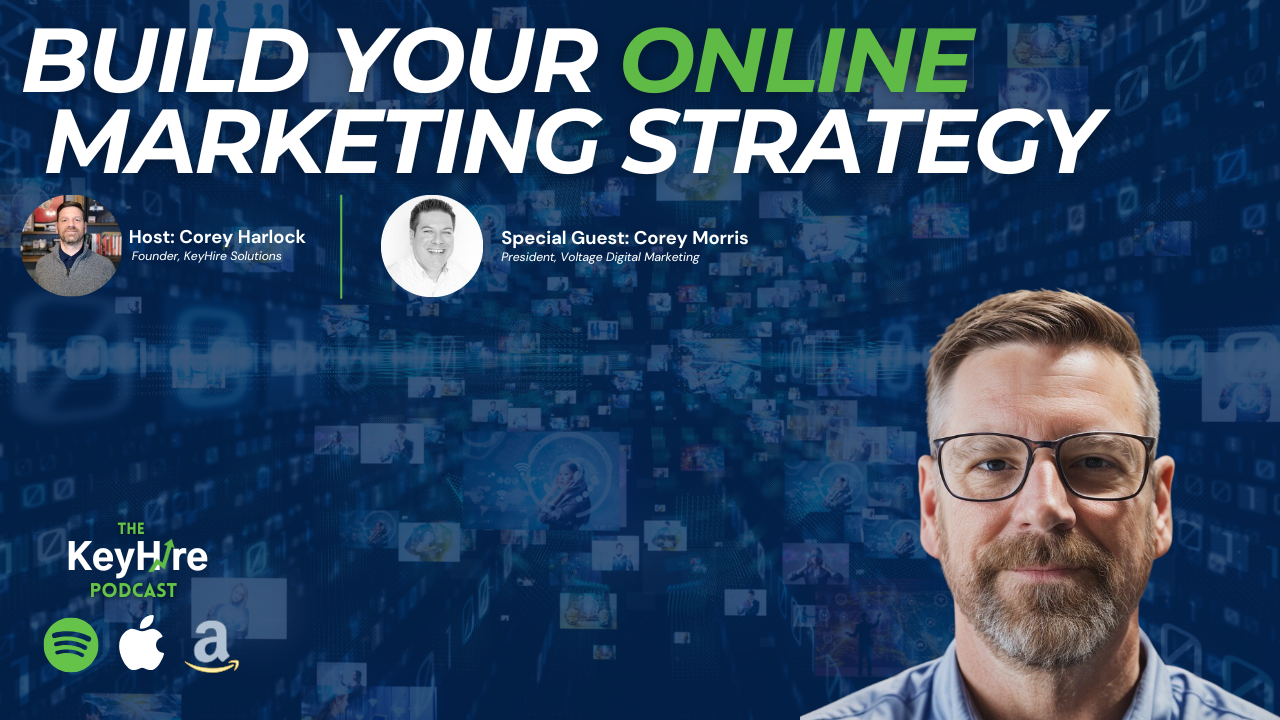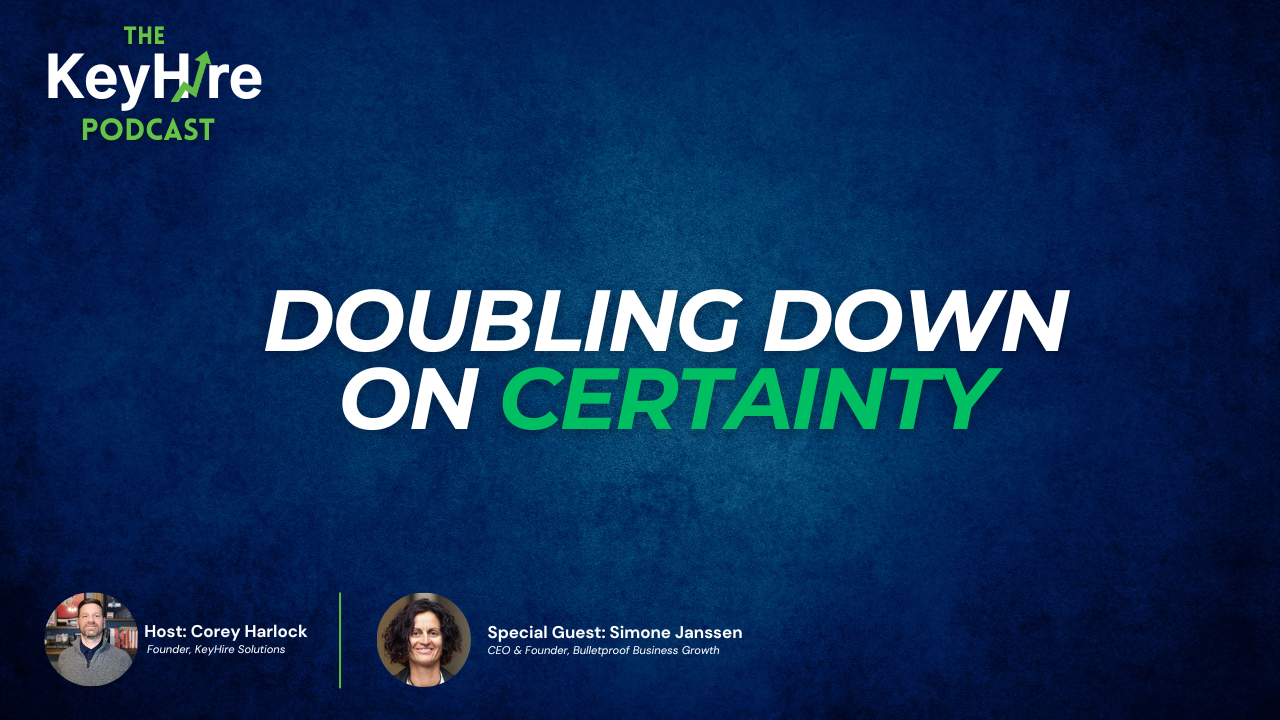Marketing Strategies for Small Businesses: Why Most Entrepreneurs Are Drowning in Digital Noise (And How to Stop)

Running a growing business with 10-50 employees is like juggling flaming torches while riding a unicycle. You're managing teams, chasing revenue goals, and trying to scale operations—and then someone tells you that you also need to master digital marketing. The result? Most business owners either freeze up completely or throw money at every shiny marketing platform, hoping something will stick.
In a recent episode of the KeyHire Small Business Podcast, host Corey Harlock sat down with Corey Morris, Founder of Voltage Digital Marketing, to cut through the marketing noise and reveal what actually works for growing businesses. The conversation revealed why most small business marketing strategies fail—and, more importantly, how to build a marketing strategy that drives real results without overwhelming your already stretched resources.
The Hidden Costs of Marketing Mayhem
One of the biggest challenges for small businesses isn't having too little marketing—it's having too much unfocused activity. Corey Morris explains the core problem: "There's a disconnect between tactics or activity and ROI. Marketing is this thing we do or this set of activities. And we don't necessarily know how to connect it to ROI. If you're not looking at marketing as an investment with an expected return on investment, it's going to be a painful line item."
This disconnect creates a cascade of problems. Business owners often assign marketing responsibilities to existing team members—usually someone who "gets social media"—without realizing they're breaking that person's focus and diminishing their core performance. The result is mediocre marketing that generates vanity metrics (likes, shares, impressions) while your phone stays silent and your inbox remains empty of qualified leads.
Even worse, many businesses discover they're actually losing money on their marketing efforts without realizing it. Companies often celebrate metrics like clicks, leads, and even initial sales while failing to track the complete customer journey. When you factor in the true cost of converting those leads, customer acquisition expenses, and long-term retention rates, what appeared to be successful marketing campaigns can reveal themselves to be money pits.
How to Scale a Business with Strategic Marketing Planning
The antidote to marketing chaos isn't more tactics—it's better planning. Large corporations spend months and hundreds of thousands of dollars on developing their strategies. While those numbers may not be feasible for growing small businesses, a streamlined approach is still needed that balances thoroughness with agility.
The Foundation: Know Your Numbers
Before diving into tactics, establish clear financial benchmarks that will guide every marketing decision. This foundational step separates successful marketing investments from expensive experiments. Calculate your customer acquisition cost and lifetime value to understand the true economics of your growth. Determine your marketing ROI expectations just like any other business investment. Set clear conversion goals that matter: qualified leads, meaningful sales calls, and closed deals that drive revenue. Most importantly, understand your sales pipeline metrics so you can work backwards from revenue goals to determine the marketing activity required to hit your targets.
The Strategy: Document Your Plan
Morris emphasizes the critical importance of getting your plan onto paper: "Keep it visible somewhere. Define your ultimate goal and the corresponding strategy. If you can't articulate this like a purpose statement for your marketing, then you're going to chase the shiny objects when they come up."
A documented strategy serves as your marketing filter, helping you say no to distracting opportunities and yes to activities that drive results. Your marketing strategy document should answer the fundamental questions:
- Who are we targeting? (Be specific about your ideal customer profile)
- What are we offering? (Your unique value proposition, not just features)
- Where will we reach them? (Which platforms align with your audience and budget)
- Why should they care? (The problem you solve and the outcome you deliver)
- How will we measure success? (Specific metrics tied to business goals)
Smart Platform Selection for Business Growth
Not all marketing platforms are created equal, and choosing the wrong one can quickly drain your budget. The key is matching platform selection to your customer behavior and business model.
For B2B companies, LinkedIn typically offers the highest ROI, while Google captures high-intent prospects. However, avoid platform bias when making decisions. Many business owners dismiss platforms based on personal preferences rather than customer data.
Your ideal customer might engage differently during personal versus professional hours. A manufacturing executive scrolling Facebook after bedtime might be more receptive to a software demo than navigating LinkedIn's professional noise during business hours.
The platform selection process should include:
- Audience Research: Validate where customers spend time using platform tools
- Competitive Analysis: Identify competitor successes and gaps
- Content Compatibility: Choose platforms aligned with your content capabilities
- Integration Potential: Prioritize platforms sharing content/audiences
- Budget Allocation: Master 1-2 platforms before expanding
The most successful small businesses focus energy on dominating one or two channels rather than spreading themselves too thin. This focused strategy offers improved ROI on both time and marketing investments.
Avoiding Mistakes That Sabotage Small Business Marketing
Even well-intentioned marketing efforts can backfire without proper execution. Here are the most common pitfalls that derail small business marketing—and how to avoid them:
- The "Test and Learn" Trap: Constantly experimenting with ad spend without proper research can waste money if you haven't done baseline research first.
- Too Many Cooks: Trying to manage marketing by committee results in inconsistent messaging and a diluted focus. Assign clear ownership and decision-making authority.
- Unrealistic Unicorn Expectations: Expecting one person to master every platform and channel leads to burnout and mediocre results across the board.
- Vanity Metrics Obsession: Focusing on likes, shares, and impressions while ignoring conversion rates and customer acquisition costs.
- Inconsistent Execution: Starting and stopping campaigns based on busy seasons or budget fluctuations prevents the compounding effects that make marketing profitable.
- Platform Proliferation: Spreading thin across multiple platforms instead of dominating 1-2 channels.
Taking Action: Your Next Steps
Ready to transform your marketing from expense to investment? Start with a commitment to the fundamentals.
First, honestly assess your current efforts. Calculate the actual cost of your marketing-ad spend, staff time, and hidden expenses. Review six months of activities and trace them to actual leads and conversions. This reveals which efforts generate real ROI versus busy work.
Document and maintain visibility of your marketing plan to ensure consistent execution and measurable results. Write down your complete marketing strategy, tactics, and testing plans—whether you handle marketing yourself or delegate it. Keep this documentation easily accessible and visible.
Most small businesses struggle with measurement, but this offers the most significant opportunity. Track prospects from their first click to becoming a paying customer. Start simple with existing tools and build consistently. Focus on numbers that impact your bottom line.
When launching, resist the temptation to test everything simultaneously. Pick one or two platforms where your ideal customers spend time and master those channels first. Allow a minimum of 90 days for results—marketing's profitable compounding effects need time to build momentum.
Key Takeaways
The path to marketing success isn't about doing more—it's about doing the right things consistently and measuring what matters. As Morris puts it: "You know what your growth goal is for the next year as a company. Distill that down to what your expectations are for marketing. Understand that for every dollar that you want to spend, how many dollars you need to get back or what that looks like for your return on investment."
- Marketing is an investment, not an expense—treat it like any other business investment with clear ROI expectations
- Strategy before tactics—document your plan and use it as a filter for every marketing decision
- Platform quality over quantity—master 1-2 channels before expanding
- Measure what matters—focus on metrics that connect to actual revenue, not vanity metrics
- Consistency compounds—irregular marketing efforts prevent the cumulative effects that drive profitability
The marketing landscape will continue evolving, but these fundamentals remain constant. By building a solid foundation and maintaining disciplined execution, you can turn marketing from a source of stress into your most reliable growth engine.
Want to dive deeper into building effective systems for your growing business? Listen to the full conversation on the KeyHire Small Business Podcast.
Learn more about Correy Morris: https://thedmsp.com
Check out our sponsor:
Career Spring, Careers launch here: https://careerspring.org/
Connect With Us:
KeyHire Solutions, Be Our Next Success Story: https://www.keyhire.solutions/testimonials
Contact Corey: corey@keyhire.solutions











